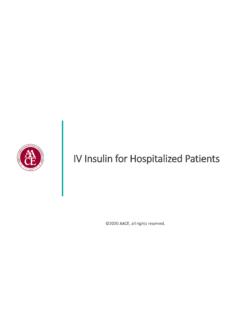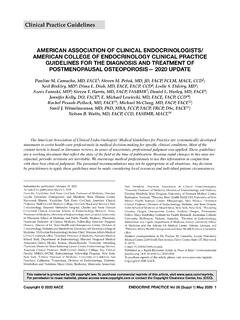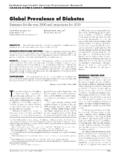Transcription of Initiating and Intensifying Insulin Therapy in Patients ...
1 1 Initiating and Intensifying Insulin Therapy in Patients With Type 2 diabetes 2020 AACE, all right and Intensification of Insulin Therapy in Patients With Type 2 diabetes An OverviewThis presentation will discuss: Insulin evolution over the last century Strategies to select and initiate Insulin treatment in Patients with T2D Current treatment algorithms and the benefits of early insulinization The profiles of available basal and prandial Insulin formulations Insulin delivery routes and formulations, including emerging options Therapeutic inertia and treatment intensification Using Insulin Therapy in combination with other antihyperglycemic agents Insulin safety, including cardiovascular safety and hypoglycemia riskT2D, type 2 100 Years of Insulin Development: 1921-20213A Century of Insulin Development and EvolutionTattersall RB.
2 In: Pickup JC, Williams G, eds. Textbook of diabetes . 3rd ed. Blackwell Science: Malden, MA; 2003 ; Drugs@FDA; ; lispro approved in US (1996) Insulin aspart and Insulin glargine approved in US (2000) Insulin glulisine approved in US (2004) Insulin detemir approved in US (2005) Insulin discovered (1921)First human treatment with bovine Insulin (1922)Protamine and protamine zinc insulins (1936)NPH Insulin (1946)Lente (zinc) Insulin (1952)+Concentrated U-500 bovine Insulin (1952)Synthetic human Insulin (1965)Recombinant human Insulin (1979) Insulin pump developed (1978) Insulin pen developed (1981)Inhaled Insulin developed but taken off market (2006)2020 Insulin degludec approved in US (2015)Inhaled Insulin approved in US (2014)NPH, neutral protamine Hagedorn.
3 US, United in development: Smart Insulin , weekly Insulin , ultra-rapid insulinsA Timeline of diabetes TechnologyAdapted from:Kovatchev B. Bioelectronic Medicine. 2018;4(14). Insulin pump Therapy and continuous glucose monitoringInhaled insulinDisposable podsSelecting Insulin vs Non- Insulin Therapy in Patients With T2D Insulin is the most potent antihyperglycemic Many factors must be considered when choosing to initiate Insulin Therapy vs other antihyperglycemic Therapeutic selection for Patients with T2D should be individualized based on patient and medication ,2 Patient attributes: Initial A1C level, diabetes duration, obesity status, age, hypoglycemia risk, and other comorbidities.
4 Medication attributes: Efficacy, mechanism of action, hypoglycemia risk, risk of weight gain, adverse events, tolerability, ease of use, likely adherence, and cost. With the goals of safety and risk reduction, select Therapy that reflects the patient s cardiac, cerebrovascular, and renal ,21. Garber A J, et al. Endocr Pract. 2020;26(1):107-139. 2. American diabetes Association. diabetes ;43(suppl 1) , type 2 Glycemic Control Algorithm: When to Consider Insulin Therapy in Patients With T2DA1C > and/or symptomatic hyperglycemia; with or without other antihyperglycemic agents In combination with 1-2 other antihyperglycemic agents when A1C is Added to monotherapy or dual Therapy when A1C goals are not met after 3 months Patients taking 2 oral agents with A1C > and/or long-standing T2D are less likely to reach target A1C with a 3rdnon- Insulin agent.
5 Adding a 3rdnon- Insulin agent may successfully reduce glycemia in some Patients , but many will eventually require A J, et al. Endocr Pract. 2020;26(1) , American Association of Clinical Endocrinologists; GLP-1 RA, glucagon-like peptide-1 receptor agonist; T2D, type 2 of treatment depends on patient and medication consideration as initial therapyOption for considerationas initial therapyAs treatment intensification8 AACE Glycemic Control AlgorithmGarber A J, et al. Endocr Pract. 2020;26(1) , alpha-glucosidase inhibitor;ASCVD, atherosclerotic cardiovascular disease; CGM, continuous glucose monitoring; CKD, chronic kidney disease; DPP4i, dipeptidyl peptidase-4 inhibitor; GLN, glinides; GLP-1 RA, glucagon-like peptide-1 receptor agonist; HFrEF, heart failure with reduced ejection fraction; LA, long-acting; MET, metformin; QR, quick-release; SGLT2i, sodium-glucose cotransporter 2 inhibitor; SU, sulfonylurea; T2D, type 2 diabetes .
6 TZD, Overall Approach to Glucose-Lowering Medication: When to Consider Insulin Therapy in Patients With T2D The early introduction of Insulin should be considered in the setting of ongoing catabolism (weight loss, hypertriglyceridemia, ketosis), symptoms of hyperglycemia, A1C levels >10%, and/or blood glucose levels 300 mg/dL. Insulin can be added to metformin (first-line Therapy ) if the A1C target is not achieved after 3 months. Due to the progressive nature of T2D, many Patients eventually require and benefit from Insulin diabetes Association. diabetes ;43(suppl 1) , American diabetes Association; T2D, type 2 other than Insulin may be preferred; choice of treatment depends on patient and medication of A1C <7% With Basal Insulin Regimen in T2D Systematic review (29 RCTs, N=17,588 Patients ) evaluating the effectiveness of Insulin analog regimens A1C <7% achieved in (95% CI: , ) Predictors of response: first Insulin treatment; lower Insulin dose; use of 2 OADs Over 30 days, mean/median hypoglycemia with basal Insulin was events/patient Weight gain: kg (95% CI: , ) 1.
7 Giugliano D, et al. Res Clin Pract. 2011;92(1) , confidence interval; OAD, oral antidiabetic drug; RCT, randomized controlled InsulinProportion of Patients with A1C <7%Study (First author, year)Pooled estimate (95% CI) ( )Riddle, 2003 Malone, 2004 Raskin, 2005 Heine, 2005 Janka, 2005 Malone, 2005 Davies, 2005 Davies, 2005 Kann, 2006 Jacober, 2006 Kazda, 2006 Kennedy, 2006 Kennedy, 2006 Kennedy, 2006 Kennedy, 2006 Hermansen, 2006 Rosenstock, 2006 Gernstein, 2006 Standl, 2006 Standl, 2006 Holman, 2007 Robbins, 2007 Barnett, 2007 Esposito, 2008 Esposito, 2008 Bretzel, 2008 Rosenstock, 2008 Rosenstock, 2008 Buse, 2009 Raz, 2009 Russell-jones, 2009 Bickle, 2009 Blonde, 2009 Blonde, 2009 Rosenstock, 2009 Strojek, 2009 Fogelfeld, 2010 Fogelfeld, 2010 Very Early Insulinization in T2D Evidence suggests that early.
8 Short-term Insulin treatment can improve glycemic control and preserve beta-cell function in Patients with newly diagnosed T2D and severe, symptomatic By treating Patients with Insulin before diabetes has progressed (typically for 2 weeks to 3 months), glucolipotoxicity is rapidly reversed, and beta-cells are given the chance to rest. 1-3 Several controlled and uncontrolled studies have shown that intensive, early, short-term Insulin Therapy can lead to sustained normoglycemia for up to 12 months in ~31%-51% of ,4-9 This treatment approach may also preserve residual beta-cell function, enabling the effective, future use of non- Insulin antihyperglycemic ,6,7111.
9 Raz I, et al. diabetes ; 36(suppl 2):S190-S197. 2. Owens DR. diabetes Technol Ther. 2013;15(9):776-785. 3. Hanefield M. diabetes Metab. 2014;40(6):391-399; 4. Ilkova H, et al. diabetes Care. 1997;20(9):1353-1356. 5. Ryan EA, et al. diabetes Care. 2004;27(5):1028-1032. 6. Li Y, et al. diabetes Care. 2004;27(11):2597-2602. 7. Weng J, et al. Lancet. 2008;371(9626):1753-1760. 8. Chen HS, et al. diabetes Care. 2008;31(10):1927-1932. 9. Mu PW, et al. diabetes Metab Res Rev. 2012;28(3) , type 2 With Ketosis-Prone T2D Require Early Insulinization Ketosis-prone T2D is characterized by the new, acute onset of hyperglycemia with ketoacidosis, requiring Patients often have a family history of T2D and are predominantly:1-4 Black or Latino Middle-aged (but can be younger) Overweight and/or obese Male Patients present with impaired Insulin secretion and action;3 the clinical course resembles Treatment requires intensive, initial Insulin for several weeks to ,3 Following Insulin discontinuation, metabolic abnormalities typically improve, and a proportion of Patients enter a period of near-normoglycemic ,3121.
10 Lebovitz HE, et al. Curr Diab Rep. 2018;18(11):120. 2. Wang X, et al. Biomed Rep. 2015; 3(4):439-442. 3. Umpierrez GE. diabetes Care. 2006;29(12):2755-2757. 4. Balasubramanyam A, et al. Endocr Rev. 2008:29(3) , type 2 Insulinization in Patients With Ketosis-Prone T2D: Remained in Remission at 10 Years Follow-up Cohort study of 111 hospitalized Patients with KP T2D (both Insulin -dependent and nondependent) of Sub-Saharan African descent With early treatment, a majority ( ) achieved remission from Insulin dependence: Mean time to remission, weeks Mean duration of remission, months At 10 years of follow-up, of Patients remained in remission Study also included Patients with T1D, T2D, and controls (see Figure)131.










